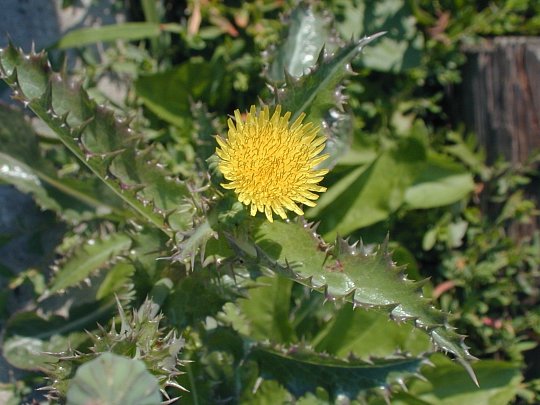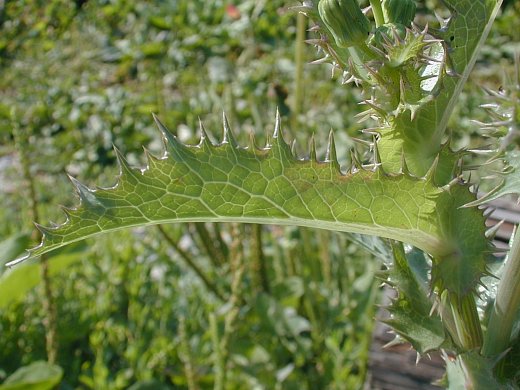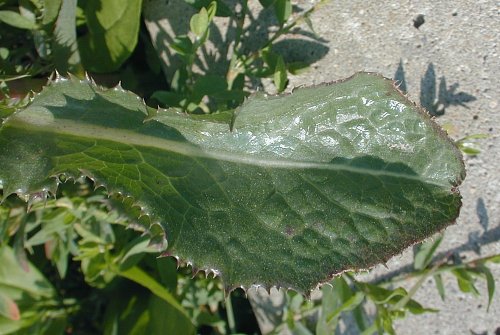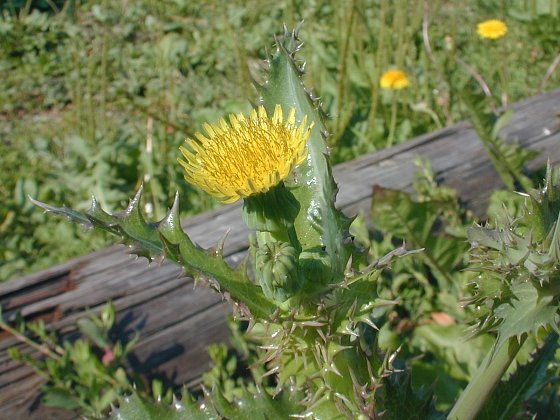Description: This plant is a spring or summer annual (usually the former) that becomes 1-3' tall, branching sparingly in the upper half. The stems are dull green or reddish green, round, and smooth. They have rather conspicuous longitudinal veins and are usually hairless, although occasionally the upper stems and flowering stalks have a few hairs. The alternate leaves are up to 10" long and 3½" across, but more commonly they are about half this size or less. On shorter plants, they are rather crowded together on the stems, even where the composite flowers occur. Depending on the local form of the plant, these leaves may be pinnatifid, or they may lack significant lobes along the margins, in which case they are broadly lanceolate or oblanceolate. The margins are conspicuously prickly, while the base of each leaf is auriculate with a pair of large rounded basal lobes that strongly clasp the stem.

The hairless leaves are glabrous, and they tend to be folded upward along the central vein. However, there are no prickles along the central vein on the underside of each leaf. Both the stems and the leaves contain a milky latex. The upper stems terminate in clusters of 1-5 composite flowers on rather short stalks. Each flower is about 2/3" (16 mm.) across when fully open, consisting of numerous yellow ray florets. The base of each flower is covered with dull green bracts and is it rather short – only about 1/3" (8 mm.) in length. The blooming period can occur from late spring to early fall, and usually lasts about a month for a colony of plants. Each floret is replaced by an achene with a tuft of silky white hairs. The achenes are flat, spindle-shaped, hairless, and have several longitudinal ribs. They are distributed by the wind. The root system consists of a stout taproot. This plant spreads by reseeding itself.

Cultivation:
Prickly
Sowthistle typically grows in full sun, moist to slightly dry
conditions, and different kinds of soil, including loam, clay-loam, and
shallow gravelly soil. The size of this plant is highly variable,
depending on the moisture and fertility of the soil. It can bolt upward
and form flowerheads very quickly during the summer.
Range & Habitat:
The non-native Prickly Sowthistle is occasional to locally common in
Illinois.
Apparently, it is uncommon or absent from many areas of NW, central,
and southern Illinois, although official records probably underestimate
its distribution (see Distribution
Map). Habitats include irregularly mowed lawns, edges of
yards and driveways, gardens, areas along roads and railroads, vacant
lots, barnyards, and waste areas. This species prefers highly disturbed
areas, and it does not present an invasive threat to natural areas to
any
significant degree. It is native to Eurasia and North Africa.

Faunal
Associations:
The flowerheads probably attract various bees, Syrphid flies,
and a butterfly, Pieris
rapae (Cabbage White). Several aphids suck
plant juices from Sonchus
spp.
(Sowthistles): they include such species as Hyperomyzus lactucae
(Currant-Sowthistle Aphid), Hyperomyzus
pallidus, Pemphigus
bursarius (Lettuce Root Aphid), Uroleucon sonchi
(Large Sowthistle Aphid), and Uroleucon
sonchellum (Blackman & Eastop, 2013). Larvae of Aulacidea tumida
(Lettuce Tumor Gall Wasp) form galls along the stems of these plants
(Felt, 1917). Among vertebrate
animals, the Franklin Ground Squirrel eats the leaves, buds, and
flowerheads of sowthistles; the Ruffed Grouse eats the leaves; and
White-tailed Deer eat the foliage and mature flowerheads of Prickly
Sowthistle, spreading the
seeds across considerable distances (Ostroff & Finck, 2003;
Bennetts, 1900; Myers et al., 2004). The Eastern Goldfinch also eats
the seeds (Martin et al., 1951/1961).
Photographic Location:
Along a gravel driveway in Urbana, Illinois. The Prickly Sowthistle in
the photographs is the unlobed form of the species.

Comments: Prickly Sow Thistle is somewhat variable in appearance because its leaves may be lobed or unlobed along the margins. There are 3 Sonchus spp. (Sowthistles) in Illinois and they are fairly similar in appearance. One of them, Sonchus arvensis (Perennial Sowthistle), is a perennial plant with spreading rhizomes and composite flowers that are 1" across or more. Prickly Sowthistle and Sonchus oleraceus (Common Sowthistle) have smaller composite flowers that are ¾" across or less. These latter two species can be distinguished from each other by the shape of the basal lobes of the leaves: the basal lobes of Prickly Sowthistle are well-rounded, while the basal lobes of Common Sowthistle are acutely angular.